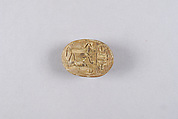Scarab Inscribed with the Name Menkheperre (Thutmose III)
New Kingdom
An oval – a debased version of the royal cartouche – is incised on the right side of the scarab’s base and contains the throne name of Thutmose III, Menkheperre. Thutmose III (Dynasty 18, ca. 1479-1425 B.C.) was a pharaoh who was venerated after his death and the name of this great ruler continued to appear on stamp seals long after his reign, even into the Late Period (ca. 664-525 B.C.). To the left of his name a horse tramples a man lying face down. His arms are bound behind his back, in the manner the ancient Egyptians represented vanquished enemies. This captive can be identified as a Levantine–named ‘Asiatic’ in Egyptian written sources–based on his goatee.
The horse was introduced in Egypt during the Second Intermediate Period (ca. 1640-1550 B.C.) and is frequently depicted in Egyptian art of the New Kingdom (ca 1550-1070 B.C.) accompanying scenes with chariots and horsemen, or as the animal of the goddess Astarte. The horse is also an animal that symbolizes the (strength of the) pharaoh and, in extension, the sun god. The fact that the horse is shown here trampling an enemy, supports its identification as a representation of the triumphant pharaoh.
This image cannot be enlarged, viewed at full screen, or downloaded.
This artwork is meant to be viewed from right to left. Scroll left to view more.





